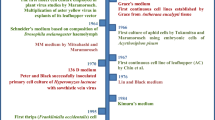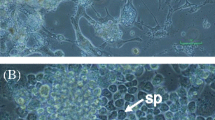Summary
This paper describes techniques for the development of continuous cell lines from insect embryos and other tissues. Methods include how to obtain aseptic primary tissues, how to dissociate the tissue, and then how to maintain the primary culture until cells grow consistently. The relative advantages of different tissues (embryos, ovaries, etc.) in establishing insect cell lines are discussed and several insect tissue culture media are described.
Similar content being viewed by others
References
Ferkovich, S. M.; Oberlander, H.; Dillard, C., et al. Purification and properties of a factor from insect hemolymph that promotes multicellular vesicle formation in vitro. Arch. Insect Biochem. Physiol. 6:73–83; 1987.
Gardiner, G. R.; Stockdale, H. Two tissue culture media for production of lepidopteran cells and nuclear polyhedrosis viruses. J. Invertebr. Pathol. 25:363–370; 1975.
Goodwin, R. H.; Adams, J. R. Nutrient factors influencing viral replication in serum-free insect cell line culture. In: Kurstak, E.; Maramorosch, K.; Dübendorfer, A., eds. Invertebrate systems in vitro. Amsterdam:Elsevier/North Holland Biomedical Press; 1980:493–509.
Grace, T. D. C. Establishment of four strains of cells from insect tissue grownin vitro. Nature 195:788–789; 1962.
Grace, T. D. C. Development of insect cell culture. In: Maramorosch, K.; Mitsuhashi, J., eds. Invertebrate cell culture applications. New York:Academic Press; 1982:1–8.
Granados, R. R.; Naughton, M. Replication ofAmsacta moorei entomopoxvirus andAutographa californica nuclear polyhedrosis virus in hemocyte cell lines fromEstigmene acrea. In: Kurstak, E.; Maramorosch, K., eds. Invertebrate tissue culture, applications in medicine, biology and agriculture. New York:Academic Press; 1976:379–389.
Hink, W. F.; Bezanson, D. R. Invertebrate cell culture media and cell lines. In: Kurstak, E., ed. Techniques in the life sciences. Limerick, Ireland: Elsevier Scientific Publishers Ireland Ltd.; 1985:1–30.
Hink, W. F.; Strauss, E. Growth of theTrichoplusia ni (TN-368) cell line in suspension culture. In: Kurstak, E.; Maramorosch, K., eds. Invertebrate tissue culture, applications in medicine, biology and agriculture. New York:Academic Press; 1976:297–300.
Lynn, D. E.; Oberlander, H. The establishment of cell lines from imaginal wing discs ofSpodoptera frugiperda andPlodia interpunctella. J. Insect Physiol. 29:591–596; 1983.
Lynn, D. E.; Dougherty, E. M.; McClintock, J. T., et al. Development of cell lines from various tissues of Lepidoptera. In: Kuroda, H.; Kurstak, E.; Maramorosch K., eds., Invertebrate and fish tissue culture. Tokyo: Japan Sci. Soc. Press; 1988:239–242.
Lynn, D. E.; Feldlaufer, M. F.; Lusby, W. R. Isolation and identification of 20-hydroxyecdysone from a lepidopteran continuous cell line. Arch. Insect Biochem. Physiol. 5:71–79; 1987.
Lynn, D. E.; Miller, S. G.; Oberlander, H. Establishment of a cell line from lepidopteran wing imaginal discs: induction of newly synthesized proteins by 20-hydroxyecdysone. Proc. Natl. Acad. Sci. USA 79:2589–2593; 1982.
Lynn, D. E.; Oberlander, H.; Ferkovich, S. M. Induction of vesicle formation in a cell line derived from imaginal discs. In Vitro 21:277–281; 1985.
Mead, G. P.; Ratcliff, N. A.; Renwrantz, L. R. The separation of insect haemocyte types on percoll gradients; methodology and problems. J. Insect. Physiol. 32:167–177; 1986.
Miltenburger, H. G.; David, P.; Wulf, H. Establishment ofMamestra brassicae cell lines and NPV-replication. In: Proceedings of the First International Colloquium on Invertebrate Pathology. Kingston, Ontario: Queen's University Press; 1976:393–394.
Mitsuhashi, J. Establishment and some characteristics of a continuous cell line derived from fat bodys of the cabbage armyworm (Lepidoptera, Noctuidae). Dev. Growth & Differ. 23:63–72; 1981.
Mitsuhashi, J. A continuous cell line derived from fat bodies of the common armyworm,Leucania separata (Lepidoptera: Noctuidae). Appl. Entomol. Zool. 18:533–539; 1983.
Mitsuhashi, J. Isolation of a continuous cell line from larval fat bodies of an Arctiid mothSpilarctia seriatopunctata (Insecta, Lepidoptera, Arctiidae). Zool. Sci. 1:415–419; 1984.
Mitsuhashi, J.; Shozawa, A. Continuous cell lines from larval hemocytes of the cabbage armyworm,Mamestra brassica. Dev. Growth & Differ. 27:599–606; 1985.
Philippe, C. Culture of fat body ofPeriplaneta americana: tissue development and establishment of cell lines. J. Insect Physiol. 28:257–265; 1982.
White, J. F.; Larsen, J. R. Morphological and physiological studies of the silkmoth ovary. I. The general histology and some histochemical properties of the ovary ofSamia cynthia (Drury). J. Morphol. 141:99–131. 1973.
Wyatt, G. R.; Loughheed, T. C.; Wyatt, S. S. The chemistry of insect hemolymph, organic composition of the hemolymph of the silkworm,Bombyx mori, and two other species. J. Gen. Physiol. 39:853–868; 1956.
Wyatt, S. S. Culturein vitro of tissue from the silkwormBombyx mori L. J. Gen. Physiol. 39:841–852; 1956.
Author information
Authors and Affiliations
Rights and permissions
About this article
Cite this article
Lynn, D.E. Methods for the development of cell lines from insects. Journal of Tissue Culture Methods 12, 23–29 (1989). https://doi.org/10.1007/BF01578004
Issue Date:
DOI: https://doi.org/10.1007/BF01578004




